Arthur Jafa’s video for Kanye West’s Wash Us In The Blood: Will Gompertz's review ★★★★☆
- Published
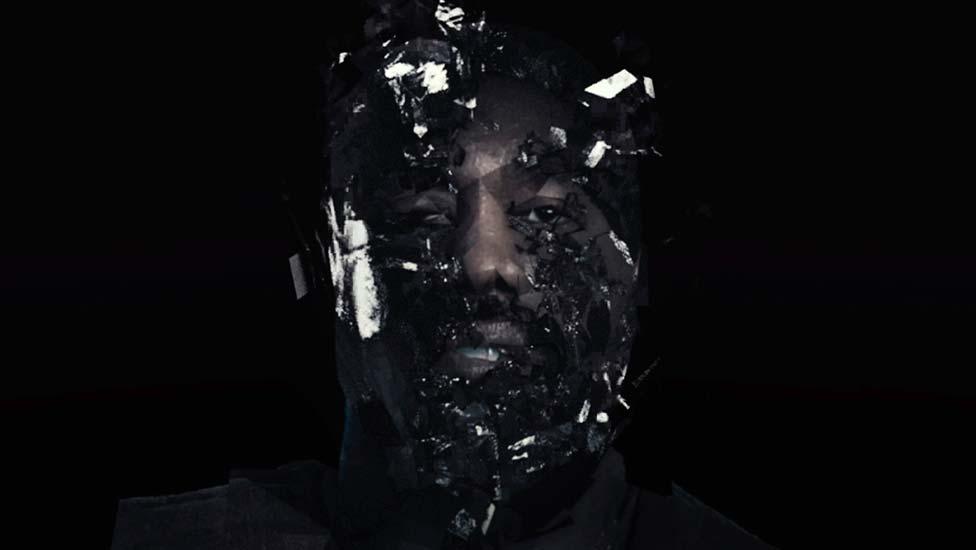
"If I was a betting man", my father used to say when on holiday and eyeing up an incoming storm before taking us kids on a long hill walk, "I'd wager we'll be just fine". We never were. We always got soaked. It was the Lake District. If it looks like storming, it storms. The weather doesn't bluff in Cumbria.
Kurt Schwitters (1887-1948) knew that.
The emigre artist moved to Ambleside via Norway in 1945 having fled Germany after Hitler included his Dadaist collages in the Nazis's Degenerate Art (Entartete Kunst) exhibitions. Schwitters called his assemblages made from magazine cuttings and assorted debris, "Merz", an invented word to describe his carefully arranged collection of bit-n-bobs.
Soon after he set up shop in the Lake District, he began the protracted process of transforming a humble stone barn into a Merzbau: a dwelling-cum-sculpture-cum-installation fabricated from twigs, string, wire, plaster and pretty much anything that came to hand.

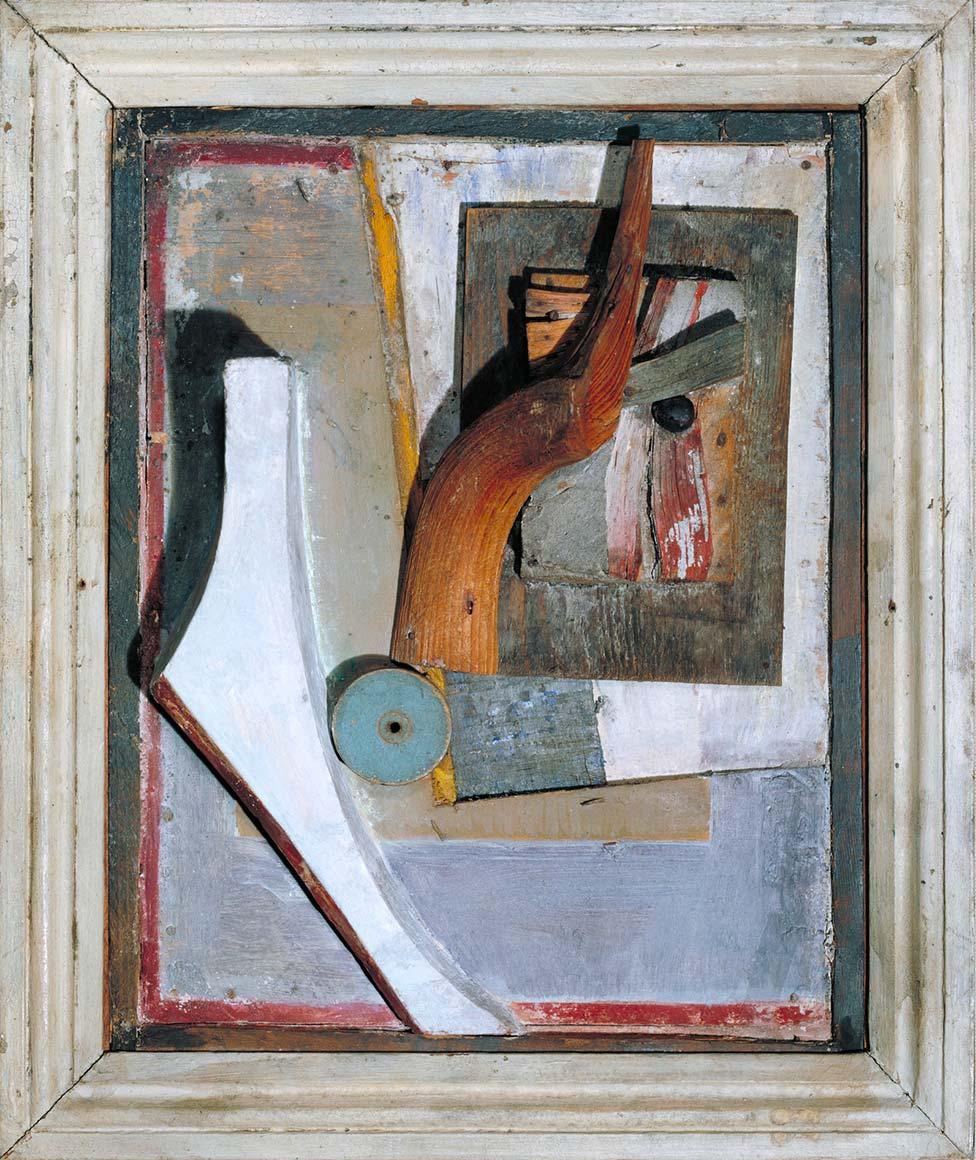
Relief in Relief (1942 -5 ) by Kurt Schwitters who said he "could see no reason why bits of driftwood, buttons and old junk from rubbish heaps should not serve well as materials for paintings"


Kurt Schwitters outside the Merz Barn with fellow artist, Hilde Goldschmidt in the village of Langdale in the Lake District, 1946/47

But the Cumbrian climate undermined his efforts; rainwater poured through the construction. Schwitters was thwarted by the weather, and by his failing health.
He died mid-project, leaving behind a leaky barn and a lasting legacy for low-fi art made with "found" objects.
His influence is evident in Robert Rauschenberg's Combines and Monty Python's animations; in the aesthetics of punk and the pioneering pop art of Eduardo Paolozzi.

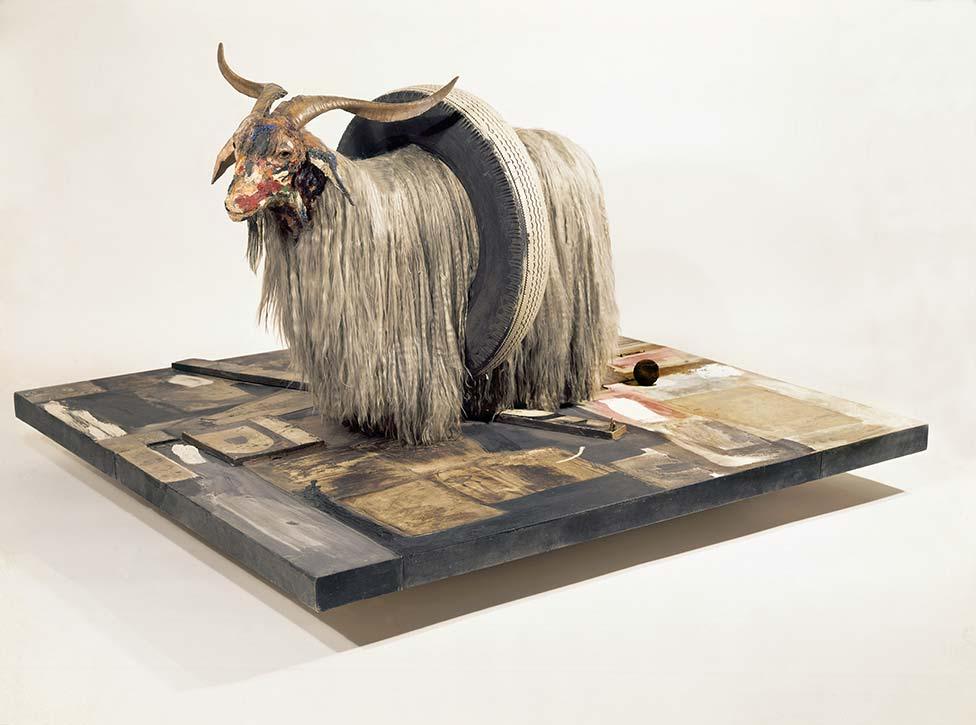
Monogram, 1955-59 by Robert Rauschenberg

Amazing, really - that Schwitters, a somewhat eccentric artist from Hanover whose work was, on occasion, destroyed and ridiculed, who became destitute and sickly, should possess a vision so potent and vital that it continues to resonate right up to this very week.
If I was a betting man, I'd wager that you have heard of Kanye West - who released a new track called Wash Us In The Blood on Tuesday - but probably not Arthur Jafa who made the accompanying video, although he's been around much longer and was awarded the Golden Lion at last year's Venice Art Biennale.

Arthur Jafa won the Golden Lion at last year's Venice Biennale for The White Album, which the jury said "critiques a moment fraught with violence but also speaks to our capacity for love"
Back in 1991, when Kanye was still in high school, Jafa won the cinematography award at the Sundance Film Festival for Daughters of the Dust. He then worked with Spike Lee and Stanley Kubrick way before West collaborated with Jay-Z on The Blueprint. But then Kanye stepped into the limelight in 2004 with his debut album College Dropout, while Arthur stayed behind the camera working mainly as a cinematographer on movies and pop promos.
Their stars aligned in 2016 when Jafa was busy piecing together a bunch of video clips and stills he'd harvested from the internet. In the spirit of Schwitters, they were fragments of stuff that had caught his eye, which he thought could be seen differently, or just seen, if structured into a coherent form from a dense mass of footage: carved out like a sculpture.
The images the Mississippi-born, architect-trained Jafa selected, coalesced into a melancholic meditation on the African American experience.
There's a clip of Barack Obama singing Amazing Grace at a service for Reverend Clementa Pinckney, who was murdered in Charleston in 2015. That lasts a few seconds. Then, a little boy slaps his mother's face and shouts, "Mummy, wake up!", Michael Jordan is on court, a young woman twerks, Martin Luther King smiles, the molten surface of the sun burns, The Notorious B.I.G raps; all of this and much more in a seven-minute-plus compilation regularly interspersed with shocking scenes of police and racists brutally assaulting black citizens.
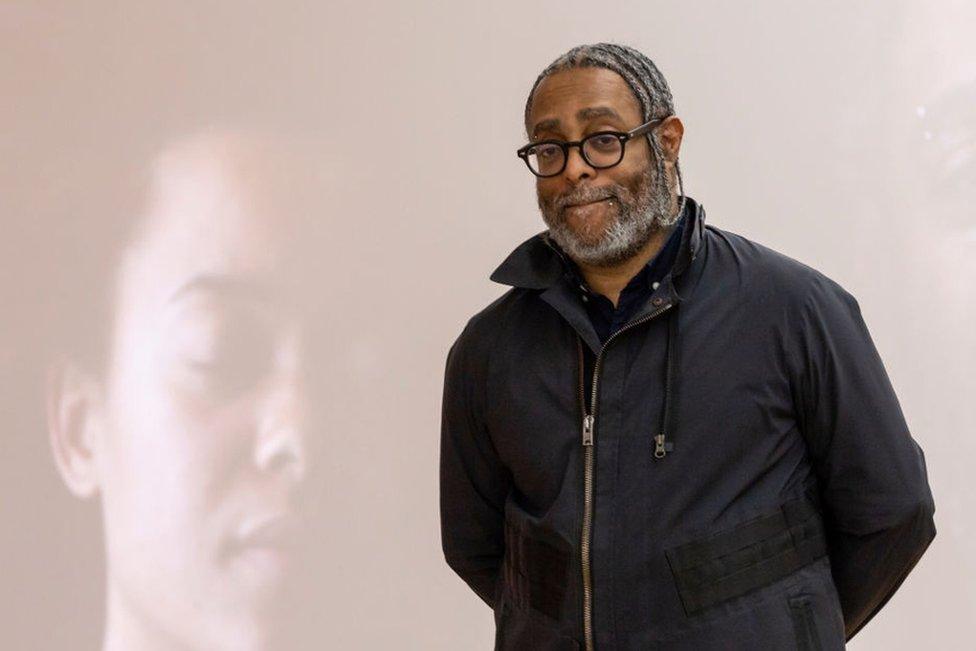
Arthur Jafa says when "black people were brought to the Americas we were not understood to be human beings, we were understood to be things"
Jafa had the video close to finished when he sat down one evening to watch Saturday Night Live, with Kanye West as the musical guest. The second number he performed, accompanied by a large choir, was the gospel-inflected Ultralight Beam. Jafa was astonished by it: a masterpiece, he thought - immediately adding it to his film. He was struck by how well it fitted, not only the mood, but also the selected images. Job done.
He called his completed work Love is the Message, The Message is Death and showed it to his friend Kahlil Joseph, who showed it at the Underground Museum in LA, and then at Art Basle in Switzerland, where the gallerist Gavin Brown saw it, and showed it in New York, at which point a video Jafa was originally going to simply upload to YouTube was re-contextualised as a museum-quality work of art and quickly became an icon of the age.
Maybe the same would have happened if Jafa had posted it online, but I wouldn't bet on it.
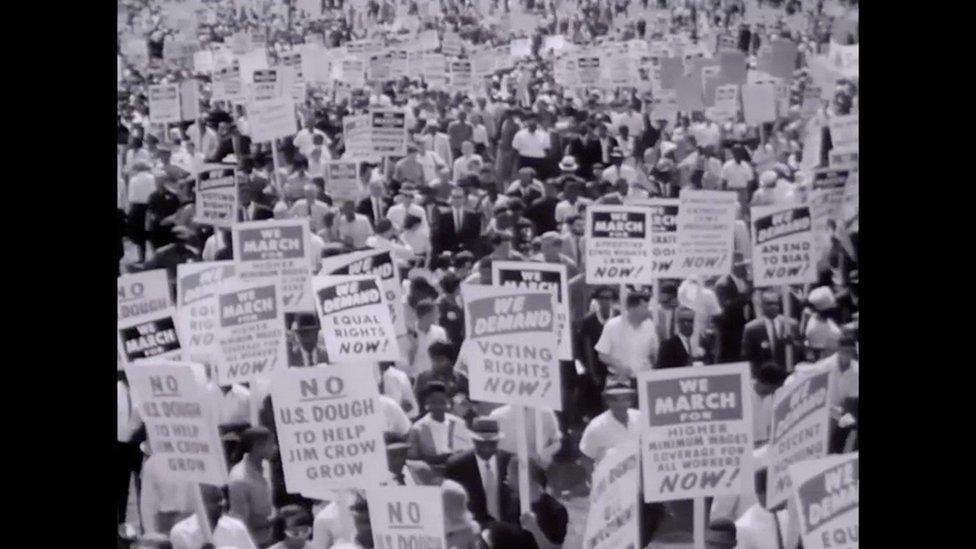
A moment from Love is the Message, The Message is Death (2016) by Jafa who says his goal is "to make black cinema with the power, beauty, and alienation of black music"
As with Kurt Schwitters, Arthur Jafa was sourcing seemingly random, buried or discarded entities that had unconsciously caught his eye, and bringing them to the surface where they could be seen. Unlike Schwitters, he was doing it with images that wouldn't have existed in the German's time or even a decade or so ago.
The smart-phone films of police brutality have only become possible because of 21st Century technology. Before the ever-present camera-phone existed, extreme and illegal acts of violence perpetrated by officers of the law were mostly unrecorded and therefore open to debate.
They're not any more.
Love is the Message, The Message is Death is an artwork crafted from this new medium, which presents a view of the world that has never, could never, have been seen before. Last weekend it was simultaneously shown by 13 museums across the globe on their websites.
On Tuesday Kanye West posted Wash Us In The Blood, a single from his forthcoming album God's Country, with a video by Jafa.
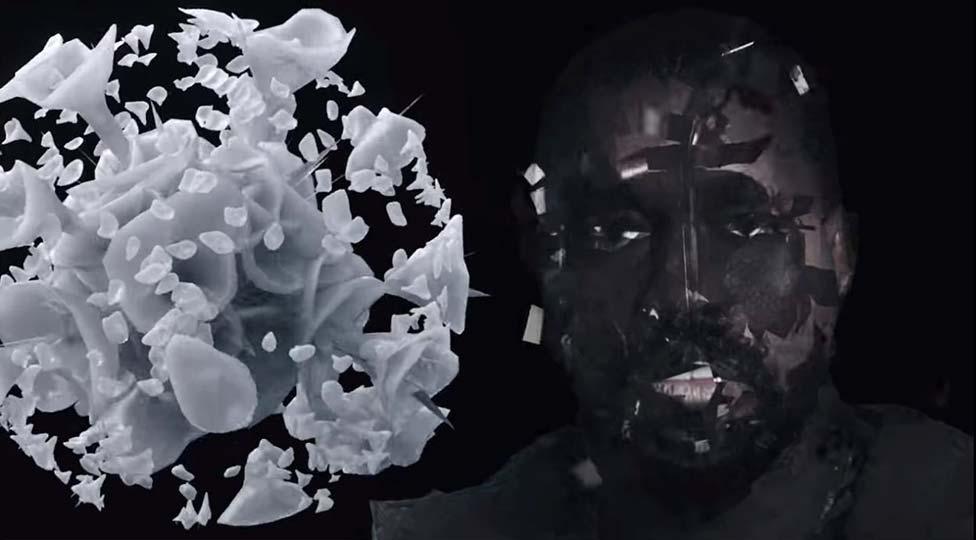
Kanye West calls on the Holy Spirit to come down, and "wash us in the blood"
It could be read as Love is the Message: The Sequel, which is a damning indictment of the continued violence targeted at a community of people because of the colour of their skin.
There's a clip of Ahmaud Arbery jogging shortly before he was shot and killed after being confronted by Gregory McMichael and his son Travis. And one of Breonna Taylor laughing and dancing at some point prior to the incident that led to her death having been shot eight times by police. Both fatal confrontations happened this spring.


Ahmaud Arbery was jogging when he was confronted by Gregory and Travis McMichael, and then fatally shot during the encounter

There are also Covid-19 references, two of which show footage of young black people struggling to breathe, a comment, perhaps, on the nature of the virus and how it affects different ethnicities and also, possibly, on the asphyxiation of George Floyd, a protest about which is where the film starts (in Fort Lauderdale after a policeman has gratuitously pushed over a kneeling black woman).

A symbolic moment from West's Wash Us In The Blood showing a woman struggling to breathe
There are cars doing donuts and taking out a section of the crowd, chains on the ocean that take the shape of Peter Saville's Unknown Pleasures album cover for Joy Division, and video game sequences in a split-screen with Kanye, whose head is covered in a clear plastic visual effect that shatters as he sings about people not wanting him to be himself.
All of this imagery is secondary to Kanye's music and lyrics, which mixes polemic with prayer and biblical references:
Genocide what it does
Mass incarc' what it does
Shortly followed by:
Execution, thirty states
Thirty states still execute
Thou shall not kill, I shall not spill.
And then…
Wash us in the blood of Jesus.
The hectic, driving urgency of the film and track subside at the end as pictures of Kanye's Sunday Service Choir rehearsing are accompanied by the sound of gospel singing.
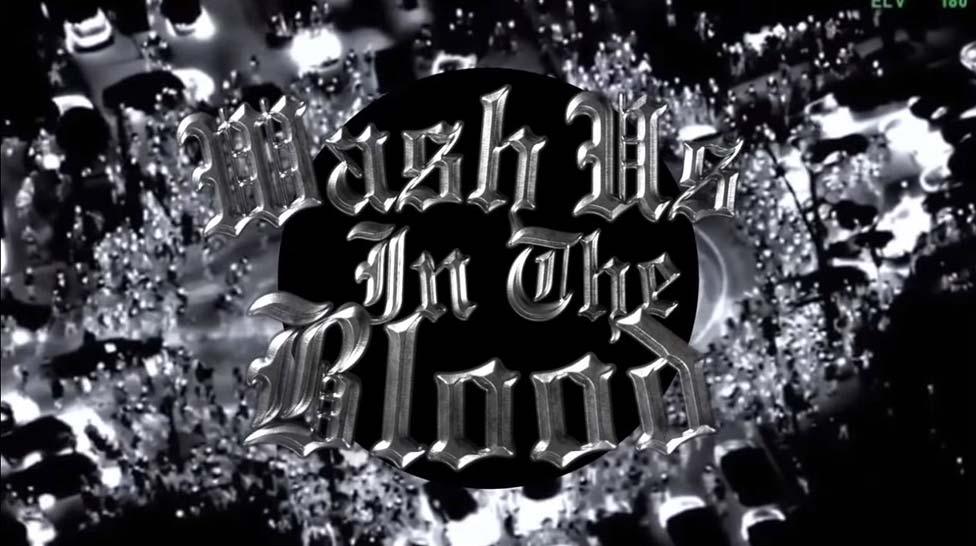
It is a good film.
But it is not as good as Love is the Message, The Message is Death, or The White Album - the video about casual racism for which Jafa won at Venice. Wash Us In The Blood is clearly part of his oeuvre, a way of making art that Arthur Jafa has been perfecting since he was a little boy putting together books of Kung-Fu movie adverts. But it lacks the rhythm and clarity of his best work. I suspect that is because the video is ultimately in service to the song, whereas the music is an afterthought in Love is the Message.
There is also an over-reliance on images and characters Jafa has used in previous pieces, perhaps because he thought a new mass audience might be unfamiliar with his earlier work. The trouble is, for those who are familiar with it, the sense of shock and discovery and sensory overload, on which his videos rely, is undermined.
So, this is not his finest work. But Arthur Jafa remains an exceptional artist - or "specialist", as he would say - whose star within the art world has risen late but shines brighter than most. He might not be as famous as Kanye right now, but he will be in 100 years' time when he will be considered one of the most important artists of the early 21st Century.
I'll take bets on it.
Recent reviews by Will Gompertz
Follow Will Gompertz on Twitter, external
